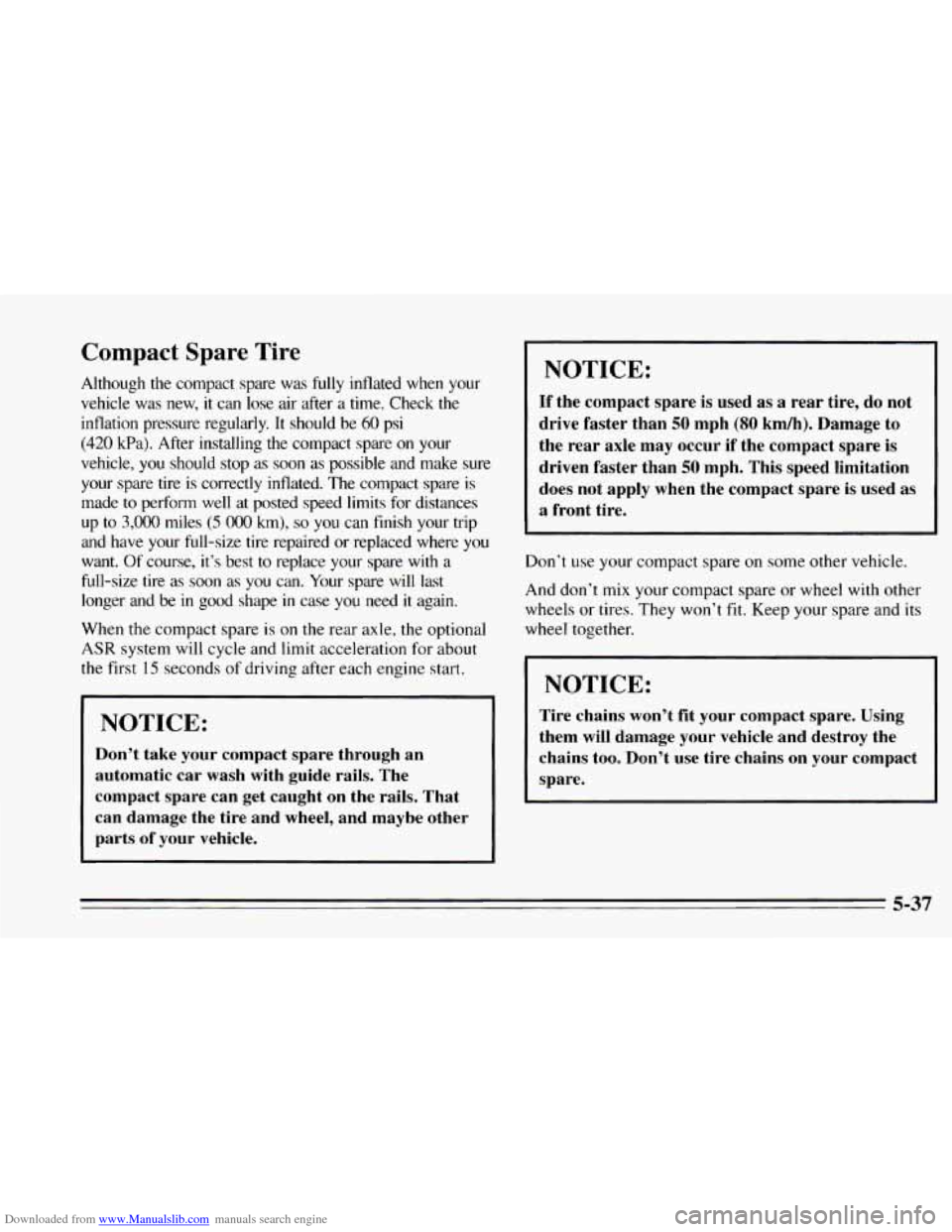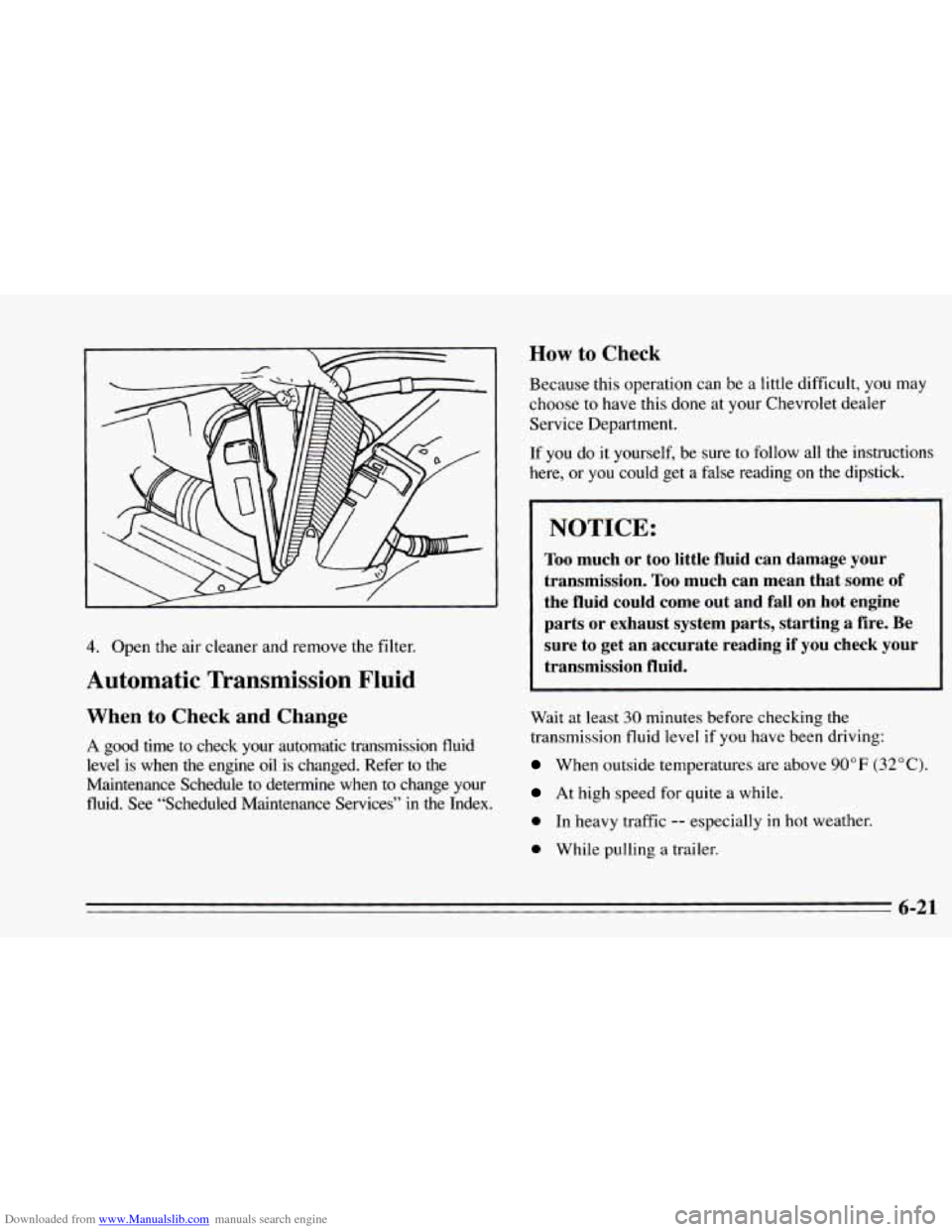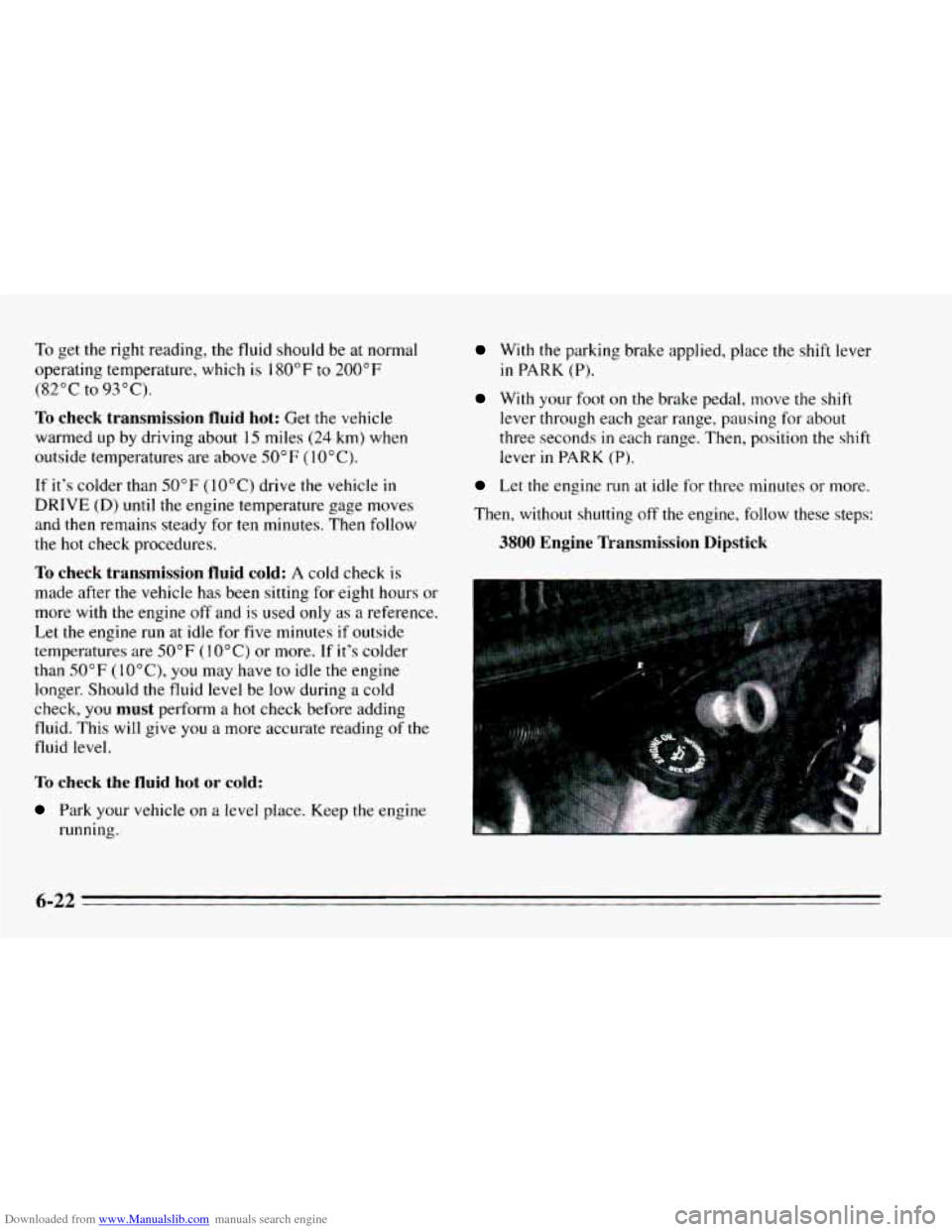Page 231 of 388

Downloaded from www.Manualslib.com manuals search engine Compact Spare Tire
Although the compact spare was fully inflated when your
vehicle was new,
it can lose air after a time. Check the
inflation pressure regularly. It should be
60 psi
(420 kPa). After installing the compact spare on your
vehicle, you should stop as soon
as possible and make sure
your spare tire is correctly inflated.
The compact spare is
made
to perform well at posted speed limits for distances
up
to 3,000 miles (5 O00 km), so you can finish your trip
and have your full-size tire repaired or replaced where
you
want. Of course, it’s best to replace your spare with a
full-size tire as soon as you
can. Your spare will last
longer and be
in good shape in case you need it again.
When the compact spare is
on the rear axle, the optional
ASR system will cycle and limit acceleration for about
the first 15 seconds of driving after each engine start.
NOTICE:
Don’t take your compact spare through an
automatic car wash
with guide rails. The
compact spare can get caught on the rails. That
can damage the tire and wheel, and maybe other
parts
of your vehicle.
I
I NOTICE:
If the compact spare is used as a rear tire, do not
drive faster than
50 mph (80 km/h). Damage to
the rear axle may occur if the compact spare
is
driven faster than 50 mph. This speed limitation
does not apply when the compact spare is used
as
a front tire.
Don’t use your compact spare
on some other vehicle.
And don’t mix your compact spare or wheel with other
wheels or tires. They won’t fit. Keep your spare and its
wheel together.
I NOTICE:
Tire chains won’t fit your compact spare. Using
them will damage your vehicle and destroy the
chains too. Don’t use tire chains
on your compact
spare.
5-37
Page 233 of 388
Downloaded from www.Manualslib.com manuals search engine 0 Section 6 Service and Appearance Care
Here you will find information about the care of your We hope you’ll want to keep your GM vehicle all GM.
Chevrolet. This section begins with service and fuel
Genuine GM parts have one of these marks:
information, and then it shows how to check important
fluid and lubricant
levels. There is also technical
information about your vehicle, and a part devoted to its
appearance care.
Service
Your Chevrolet dealer knows your vehicle best and
wants you
to be happy with it. We hope you’ll go to
your dealer for
all your service needs. You’ll get
genuine GM parts and GM-trained and supported
service people.
n-
Delco
6-1
Page 237 of 388

Downloaded from www.Manualslib.com manuals search engine Gasolines for Cleaner Air
Your use of gasoline with deposit control additives will
help prevent deposits from forming
in your engine and
fuel system. That helps keep your engine in tune and
your emission control system working properly. It’s
good for your vehicle, and you’ll be doing your part for
cleaner air.
Many gasolines are now blended with oxygenates.
General Motors recommends that you use gasolines with
these blending materials, such as MTBE and ethanol. By
doing
so, you can help clean the air, especially in those
parts of the country that have high carbon monoxide
levels.
In addition, some gasoline suppliers are now producing
reformulated gasolines. These gasolines are specially
designed
to reduce vehicle emissions. General Motors
recommends that you use reformulated gasoline. By
doing
so, you can help clean the air, especially in those
parts
of the country that have high ozone levels.
You should ask your service station operators if their
gasolines contain deposit control additives and oxygenates, and
if they have been reformulated to
reduce vehicle emissions.
Fuels in Foreign Countries
If you plan on driving in another country outside the
U.S. or Canada, unleaded fuel may be hard to find. Do
not use leaded gasoline. If you use even one tankful,
your emission controls won’t work well or at all. With
continuous
use, spark plugs can get fouled, the exhaust
system can corrode, and your engine oil can deteriorate
quickly. Your vehicle’s oxygen sensor will be damaged.
All of that means costly repairs that wouldn’t be covered
by your warranty.
To check on fuel availability, ask an auto club, or
contact a major oil company that does business in the
country where you’ll be driving.
You can also write us at the following address for
advice. Just tell us where you’re going and give your
Vehicle Identification Number (VIN).
General Motors Overseas Distribution Corporation
North American Export Sales (NAES)
1908 Colonel Sam Drive
Oshawa, Ontario
L1H 8P7
6-5
Page 239 of 388
Downloaded from www.Manualslib.com manuals search engine Checking Things Under the Hood
Hood Release
To open the hood, first pull the. handle inside the lower
left side
of your vehicle.
n
L/ I Ill- -
Then go to the front of the vehicle and pull up on the
hood release located at the center area of the hood.
Lift the hood.
Page 243 of 388
Downloaded from www.Manualslib.com manuals search engine Then just pull the hood down and close it firmly.
Before closing
the hood, be sure
all the filler caps are
on.
Engine Oil
LOW blL
If the “LOW OIL” light on the instrument panel comes
on, it means you need to check your engine oil level
right away. For more information, see “Low Oil”
in the
Index. You should check your engine oil level regularly;
this is an added reminder.
It’s
a good idea to check your engine oil every time you
get
fuel. In order to get an accurate reading, the oil must
be warm and the vehicle must be on level ground.
6-11
Page 245 of 388
Downloaded from www.Manualslib.com manuals search engine 5.7 L - Ltl (Code P) Oil Dipstick Location To Check Engine Oil
Pull out the dipstick and clean it with a paper towel or
cloth, then push it back in all the way. Remove it again,
keeping the
tip down, and check the level.
3.4 L - L32 (Code S) and 3800 - L36 (Code K)
Turn off the engine and give the oil a few minutes to
drain back into the oil pan. If you don’t, the oil dipstick
might
not show the actual level.
6-13
Page 253 of 388

Downloaded from www.Manualslib.com manuals search engine 4. Open the air cleaner and remove the filter.
Automatic Transmission Fluid
When to Check and Change
A good time to check your automatic transmission fluid
level is when the engine oil is changed. Refer to the
Maintenance Schedule to determine when to change your
fluid. See “Scheduled Maintenance Services” in the Index.
How to Check
Because this operation can be a little difficult, you may
choose to have this done at your Chevrolet dealer
Service Department.
If you do it yourself,
be sure to follow all the instructions
here,
or you could get a false reading on the dipstick.
NOTICE:
Too much or too little fluid can damage your
transmission.
Too much can mean that some of
the fluid could come out and fall on hot engine
parts or exhaust system parts, starting a fire. Be
sure to get an accurate reading if you check your
transmission fluid.
Wait at least 30 minutes before checking the
transmission fluid level
if you have been driving:
When outside temperatures are above 90°F (32°C).
At high speed for quite a while.
0 In heavy traffic -- especially in hot weather.
0 While pulling a trailer.
Page 254 of 388

Downloaded from www.Manualslib.com manuals search engine To get the right reading, the fluid should be at normal
operating temperature, which
is 180°F to 200°F
(82°C to 93°C).
To
check transmission fluid hot: Get the vehicle
warmed up by driving about
15 miles (24 km) when
outside temperatures are above
50°F (10°C).
If it's colder than
50°F (10°C) drive the vehicle in
DRIVE (D) until the engine temperature gage moves
and then remains steady for ten minutes. Then follow
the hot check procedures.
To check transmission fluid cold: A cold check is
made after the vehicle has been sitting for eight hours or
more with
the engine off and is used only as a reference.
Let the engine run at idle for five minutes
if outside
temperatures are
50°F (10°C) or more. If it's colder
than
50°F (lO"C), you may have to idle the engine
longer. Should the fluid level be low during
a cold
check,
you must perform a hot check before adding
fluid. This will give you a more accurate reading
of the
fluid level.
To check the fluid hot or cold:
Park your vehicle on a level place. Keep the engine
running.
With the parking brake applied, place the shift lever
in PARK (P).
With your foot on the brake pedal, move the shift
lever through each gear range, pausing for about
three seconds
in each range. Then, position the shift
lever
in PARK (P).
Let the engine run at idle for three minutes or more.
Then, without shutting off the engine, follow these steps:
3800 Engine Transmission Dipstick
6-22